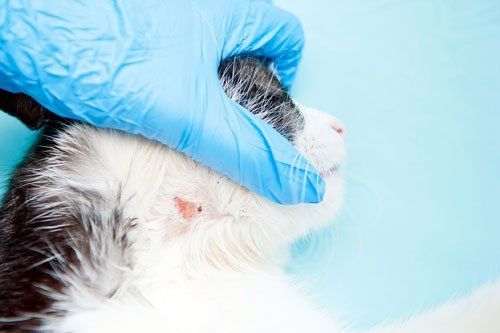How to Prevent the Spread of Ringworm
10 July 2018

The name ringworm
may lead people to think that a ringworm is a parasite that infects your pet’s body. It is not. The problem arises when fungi known as dermatophytes infect the skin. Ringworm often appears on areas of the body that are warm and moist. It is not dangerous, but a ringworm infection is unappealing and uncomfortable and spreads easily between pets and from pet to people.
Recognize the Symptoms
Ringworm infects both cats and dogs, but dogs usually have symptoms that are more visible. Common signs of ringworm infection in dogs include circular patches of hair loss, poor condition of the coat, and dandruff. The skin may be red or crusty or have sores. Some dogs are itchy and develop lesions. The claws could be brittle and misshapen if the infection spreads to the dog’s nails.
Cats may have mild symptoms like redness of the skin and dandruff, or the infection could be more severe and cause widespread skin lesions. Another sign of infection includes bald patches where the skin is flaky and red in the center of the circular patch.
Some animals are asymptomatic. The pet carries the spores and transmits the fungus to others despite showing no signs of having the disease. Take household pets to the veterinarian if human family members continuously suffer from the infection without any known cause.
Know the Risks
Any cat, dog, or human can develop a ringworm infection. However, some are more susceptible than others are. Kittens, puppies, and elderly animals have an elevated risk of infection. Animals that have immune system disorders or skin conditions or that are malnourished also catch the infection more easily. Longhaired cat breeds tend to become infected more than other cats.
Get Medical Help
Treatment relies on an exact diagnosis because other conditions can look like ringworm. Some of these include lupus, Lyme disease, and psoriasis. A visit to the vet could include looking at the infected areas under ultraviolet light, reviewing the hair under a microscope, or inspecting a culture from skin scrapings or a skin biopsy.
Oral medications, topical creams, or shampoo help to heal the infection. Over-the-counter medicines help to cure some infections, but severe cases rely on prescription medication. The method of treatment depends on the severity of the problem. An antibiotic will treat any secondary infection caused by excessive scratching or severe lesions.
Prevent the Spread
It can take 48 hours of treatment before the pet is no longer contagious. Isolating the animal in a kennel or another room during this time can help to prevent the spread of the infection. If one pet is infected, all pets in the house should be examined to prevent any future infections.
Wash and disinfect or throw out all pet toys and bedding. Wash sheets, blankets, sofas, and other soft furnishings if the pet sits on them. Avoid too much physical contact with the pet over the first couple of days and always wash your hands after handling or petting an infected animal. Clean and disinfect pet carriers and kennels and clean vehicle seats.
Do not stop treating the animal once the lesions clear or the hair begins to regrow. Some fungal spores could still be active and can re-infect the pet or infect others after the medication ends. The full course of treatment lasts long enough to kill all fungi.
Cats and dogs can suffer from diverse types of skin disorders. Not all are contagious, but all cause some level of discomfort to the pet. Make an appointment today at the Pet Medical Center of Vero Beach for diagnosis of any unusual skin symptoms. It will help to prevent the spread of any contagion and make the pet happier and healthier.
Recognize the Symptoms
Ringworm infects both cats and dogs, but dogs usually have symptoms that are more visible. Common signs of ringworm infection in dogs include circular patches of hair loss, poor condition of the coat, and dandruff. The skin may be red or crusty or have sores. Some dogs are itchy and develop lesions. The claws could be brittle and misshapen if the infection spreads to the dog’s nails.
Cats may have mild symptoms like redness of the skin and dandruff, or the infection could be more severe and cause widespread skin lesions. Another sign of infection includes bald patches where the skin is flaky and red in the center of the circular patch.
Some animals are asymptomatic. The pet carries the spores and transmits the fungus to others despite showing no signs of having the disease. Take household pets to the veterinarian if human family members continuously suffer from the infection without any known cause.
Know the Risks
Any cat, dog, or human can develop a ringworm infection. However, some are more susceptible than others are. Kittens, puppies, and elderly animals have an elevated risk of infection. Animals that have immune system disorders or skin conditions or that are malnourished also catch the infection more easily. Longhaired cat breeds tend to become infected more than other cats.
Get Medical Help
Treatment relies on an exact diagnosis because other conditions can look like ringworm. Some of these include lupus, Lyme disease, and psoriasis. A visit to the vet could include looking at the infected areas under ultraviolet light, reviewing the hair under a microscope, or inspecting a culture from skin scrapings or a skin biopsy.
Oral medications, topical creams, or shampoo help to heal the infection. Over-the-counter medicines help to cure some infections, but severe cases rely on prescription medication. The method of treatment depends on the severity of the problem. An antibiotic will treat any secondary infection caused by excessive scratching or severe lesions.
Prevent the Spread
It can take 48 hours of treatment before the pet is no longer contagious. Isolating the animal in a kennel or another room during this time can help to prevent the spread of the infection. If one pet is infected, all pets in the house should be examined to prevent any future infections.
Wash and disinfect or throw out all pet toys and bedding. Wash sheets, blankets, sofas, and other soft furnishings if the pet sits on them. Avoid too much physical contact with the pet over the first couple of days and always wash your hands after handling or petting an infected animal. Clean and disinfect pet carriers and kennels and clean vehicle seats.
Do not stop treating the animal once the lesions clear or the hair begins to regrow. Some fungal spores could still be active and can re-infect the pet or infect others after the medication ends. The full course of treatment lasts long enough to kill all fungi.
Cats and dogs can suffer from diverse types of skin disorders. Not all are contagious, but all cause some level of discomfort to the pet. Make an appointment today at the Pet Medical Center of Vero Beach for diagnosis of any unusual skin symptoms. It will help to prevent the spread of any contagion and make the pet happier and healthier.
If left untreated, roundworms and hookworms can cause serious health problems for your pet. Read about the signs in this blog and how to take action.
Many pet owners overlook the importance of dental health in their pets. Read this blog to learn why dental health is so important for your animal companion.
Your beloved pets, whether our loyal canines or our independent felines, play an integral role in your life. Read on to learn how to manage their stress.
Dogs can suffer from a plethora of digestive issues. But how can you tell if your pup has any digestive issues? Discover some key signs to look out for.
A tick’s bite can spread deadly diseases to you and your pet. Learn about a few tick-borne conditions your pet may contract if they spend time outside.
Has your animal's hair changed? Discover what this might mean and if your best friend might need treatment for their potential problem.
Prepare your puppy for its first vet visit to avoid challenges during a medical examination. This post highlights five ways to help your puppy.
If your dog is pregnant, you might feel unprepared. Read this blog to learn everything you should know about canine pregnancy, labor, and delivery.
A surgery is an invasive procedure that requires preparation to ease your cat and ensure a smooth recovery. Discover tips to prepare your cat for surgery.
Just like humans, pets can face various health issues. Learn about the most common conditions that pets face and how to avoid and treat them.





